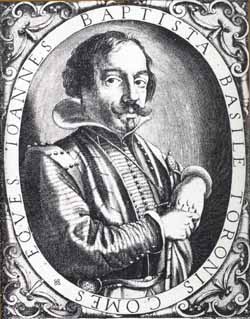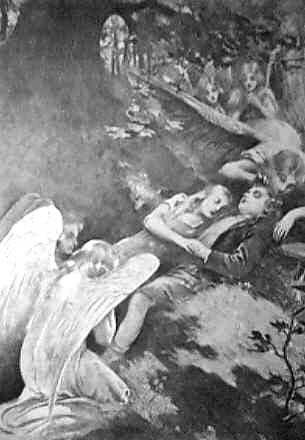The "Wild Swans" tale type, mostly known now through the stories of Hans Christian Andersen and the Grimms, has an older literary precedent in Basile's "The Seven Doves" (1634-6).
Adam of
Fairy Tale Fandom had done a
post not too long ago on Basile's Tale of Tales and how they are much cruder than fairy tale versions we're usually familiar with, which is certainly true (for example, at one point in this tale a cat doesn't just put out a fire, it pisses on the fire to put it out). But I never really realized how
Basile is often very funny, in his specific yet delightful imagery. Some of my favorite examples:
-The tale opens: "Once upon a time...there was a good woman who gave birth to a son every year so that, when the number reached seven, the boys resembled the flute of Pan with seven holes each a little bigger than the next. As soon as the sons had grown and lost their first set of ears..." (Zipes notes that this implies that children lose sets of ears like they do teeth)

-"Finally, one morning, when the sun was using his penknife to scratch out the mistakes that the night had made on heaven's papers..."
-[the heroine] "felt like a plucked quail for the mistake she had made"
-"...the sea was beating the rocks with the stick of the waves because they did not want to do the Latin homework that had been assigned them"
-"she arrived at the foot of a killjoy mountain that poked its head through the clouds just to annoy them"
Basile seemed to have an imaginative, almost childlike way in which he viewed the world with humor and personification.
The tale itself begins with the seven brothers demanding that their mother, who is again pregnant (Heaven help her), give birth to a girl this time, or else they will leave. This element of the tale always perplexes me-in
the Grimms' "Twelve Brothers," they changed their original plot in which the King threatens to kill his wife is she gives birth to a girl, to the King desiring a daughter and threatening to kill his sons if he doesn't get one. And here we see the brothers themselves determined not to have an eighth boy. I'm not sure what the intention of each author was in each of those strange and sad scenarios, but I'm beginning to wonder, given the extremity of each threat and how different each one is, if maybe this scene could represent the foolishness of putting pressure on a woman to give birth to any gender?
Anyway, the mother does give birth to a girl, but it's the midwife who was distracted and gave the boys the wrong signal, so they left. As the girl grew up, she demanded to go find news of her brother, and went on a journey. She finally found her brothers, who had taken up residence with an ogre who was friendly towards them, but hated women, since a woman had blinded him. So they put her in a room and instructed her to never show herself to the ogre.
Yet, one day, her fire was put out by her cat companion since she didn't share half of a nut that she ate with it (she usually gave it exactly half of all of her food), and she went to ask the ogre for fire. When she realized the ogre was going to harm her, she barricaded herself in her room, and when the brothers returned, they shoved the ogre into a pit, where he died. They scolded their sister for neglecting her instructions, and told her never to gather grass near the spot where the ogre was buried, or else they would be turned into doves.
But of course...one day the sister, Cianna, came across an injured man, and used rosemary from that spot to make him a healing salve. The brothers-turned-doves came and berated her, going on and on about how foolish she had been and how there was no hope for them unless she found the Mother of Time.
So Cianna went on another journey, this time to find the Mother of Time. She came across many creatures who all pointed her in the right direction, if in turn she would ask a favor of the Mother of Time for them-a whale, a mouse, an army of ants, and an oak tree. Eventually she came across the same man she had helped with the rosemary from the ogre's resting place, who gave her final instructions and then decayed away as soon as he told her everything she needed to know.
This time Cianna followed the instructions perfectly, although the Mother of Time tried to deceive her. She received an answer for all of the friends who helped her along her journey as well as the solution for her brothers to regain their human form-they must "make their nest on the column of wealth," which they unintentionally did anyway when they landed on the horn of an ox, since the horn, Basile tells us, is a symbol of plenty.
From there they journeyed backwards. The oak told them to take the gold treasure that was buried underneath him in thanks, but theives took their gold and tied them all up. The other animals all helped rescue the siblings and get them their treasure and to safety.
Although on the surface, the tale seems to have a
strong message about Cianna learning to follow instructions, the plot seems to contradict this a bit. And frankly, just reading the tale, there are so many sets of specific instructions she gets, it's almost tiring to read them. If she hadn't showed herself to the ogre the brothers wouldn't have become the lords of his castle (and she would never have been free). And the old man she helped heal with the rosemary was instrumental in freeing her brothers later, although that was helping to solve the problem she created by helping him-but clearly compassion was credited to her as a virtue and not a weakness, both in her desire to help him and then all of the other creatures who repaid them with help. In fact, the story ends: "Thanks to Cianna's goodness, they enjoyed a happy life proving the truth of the old proverb:
Good things happen to those who forget the good they've done."
The text of this tale can be found in Jack Zipes'
The Great Fairy Tale Tradition. There is an
online text at Surlalune although some of the translation is different
Illustrations-Giambattista Basile (
from wikipedia); "The Seven Doves," Warwick Goble
 Sleep can also be a dangerous, unguarded time, for heroes and villains. In "Hop o' My Thumb," the titular main character tricks the ogre into killing his sleeping daughters instead of himself and his brothers, and they use the rest of the night to escape. Many protagonists must escape a villain's house during the night, under the cover of darkness-so what is risky for one character is protection for another.
Sleep can also be a dangerous, unguarded time, for heroes and villains. In "Hop o' My Thumb," the titular main character tricks the ogre into killing his sleeping daughters instead of himself and his brothers, and they use the rest of the night to escape. Many protagonists must escape a villain's house during the night, under the cover of darkness-so what is risky for one character is protection for another.











